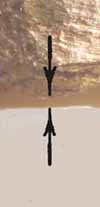INTRODUCTION
MATERIALS AND METHODS
1) Preparation of teeth
Design A: A complete crown preparation with a buccal shoulder (1 mm wide) and bevel as remaining finish line.
Design B: A complete crown preparation with a chamfer finish line.
Design C: A three-quarter crown preparation with proximal boxes and beveled finish line (Fig. 1).
2) Fabrication of custom tray
3) Impressions of teeth
4) Die preparation
5) Fabrication of wax pattern and investment
6) Fabrication of castings
7) Measurement of marginal fit
8) Evaluation of marginal adaptation using explorer
9) Evaluation of marginal adaptation using elastomeric disclosing media
10) Evaluation of marginal adaptation using Stereomicroscope
RESULTS
DISCUSSION
CONCLUSION
The preparation designs examined in this study did not significantly affect the marginal adaptation and accuracy of the castings.
Commonly used clinical evaluation techniques i.e. explorer and elastomeric disclosing media may be inadequate for assessments of marginal accuracy.
Explorer technique proved to be better aid in detection of marginal accuracy as compared to elastomeric disclosing media.
At 30 µm explorer revealed 39% sensitivity and 91% specificity and elastomeric disclosing media revealed 10.06% sensitivity and 82% specificity.
For better evaluation of marginal accuracy of the cast restorations, the routine use of a stereomicroscope in the laboratory is indicated which provides a superior quality control prior to examination of restorations intraorally.




 PDF
PDF ePub
ePub Citation
Citation Print
Print
















 XML Download
XML Download